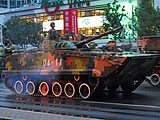Behold China’s ‘Missile Parade’
By Graham Ong-Webb for ISN
Two land-attack cruise missiles (LACMs), the YJ-91 and the DH-10, have been unveiled. With their existence now in the open, China can no longer be described as having a ‘nascent’ LACM capability. Such missiles are clearly part of the PLA’s operational inventory. There is a reason for concern. In an age of burgeoning missile defenses, the LACM is now expected to get through where the ballistic missile cannot.
The YJ-91 is exemplary in this regard. Based on the Russian Kh-31P, the YJ-91 anti-radiation missile, which also comes as an anti-ship variant, is a highly sophisticated weapon designed to detect and destroy radar and communication installations upon which the conduct of network-centric warfare by modern armies increasingly depend.
The anti-ship version is capable of cruising no more than 20 meters above sea level. This is well below the scope of enemy radar. In fact, at the terminal stage of its flight, the missile drops another 10 meters, and if the sea state allows, it skims above the ocean’s surface at a mere 1.2 meters. The missile then pops up before diving into its target.
The YJ-91 will be a serious challenge to Taiwan's Patriot Air and Missile Defense System even after the US Army Aviation and Missile Command upgrades it to counter cruise missile threats.
The DH-10 is a three-missile tube variant of the Russian Raduga Kh-55 cruise missile. Having reverse-engineered the Kh-55 from half a dozen units purchased from Ukraine in the 1990s, China has successfully produced a more robust model, which has a range exceeding 1,500 kilometers. About 200 DH-10s are known to be deployed along the Chinese coast across from Taiwan.
Though some ballistic missiles have been featured in previous parades, they now exude significant improvements.
The conventionally tipped DF-11 short-range ballistic missile (SRBM) appears to carry a modified warhead to increase the chances of penetrating Taiwanese missile defenses. The conventionally tipped DF-15 SRBM also appears to have undergone an upgrade to include new warhead stabilizer fins for better accuracy. One study suggests that it would take only 240 DF-15s to decimate Taiwan's entire air force on the ground. China has a 1,000.
Thirdly, the nuclear-tipped DF-21C medium-range ballistic missile (MRBM) also seems to be equipped with a new engine. The wider intelligence community has assessed the DF-21C to be a prime candidate for China’s future anti-ship ballistic missile program. If selected, this MRBM will serve as a vital instrument of China’s anti-access strategy by staving off the US Navy, and its aircraft carriers in particular, from China’s coastline out to a distance of 1,700 kilometers. Unless the DF-21C missile sites can be located and destroyed with confidence, the US Navy would be deterred from coming to Taiwan’s assistance during a cross-Straits conflict.
Overall, China’s burgeoning ballistic and cruise missile systems reflect the country’s growing strategic reach. They may also affirm the view that if Chinese leaders intend to secure the Pacific littoral and project power eastward, the key to this ‘break-out’ is clearly Taiwan, which they must reclaim at some point. The PLA ought to be continuously observed, even without the ticker tape.
The YJ-91 is exemplary in this regard. Based on the Russian Kh-31P, the YJ-91 anti-radiation missile, which also comes as an anti-ship variant, is a highly sophisticated weapon designed to detect and destroy radar and communication installations upon which the conduct of network-centric warfare by modern armies increasingly depend.
The anti-ship version is capable of cruising no more than 20 meters above sea level. This is well below the scope of enemy radar. In fact, at the terminal stage of its flight, the missile drops another 10 meters, and if the sea state allows, it skims above the ocean’s surface at a mere 1.2 meters. The missile then pops up before diving into its target.
The YJ-91 will be a serious challenge to Taiwan's Patriot Air and Missile Defense System even after the US Army Aviation and Missile Command upgrades it to counter cruise missile threats.
The DH-10 is a three-missile tube variant of the Russian Raduga Kh-55 cruise missile. Having reverse-engineered the Kh-55 from half a dozen units purchased from Ukraine in the 1990s, China has successfully produced a more robust model, which has a range exceeding 1,500 kilometers. About 200 DH-10s are known to be deployed along the Chinese coast across from Taiwan.
Though some ballistic missiles have been featured in previous parades, they now exude significant improvements.
The conventionally tipped DF-11 short-range ballistic missile (SRBM) appears to carry a modified warhead to increase the chances of penetrating Taiwanese missile defenses. The conventionally tipped DF-15 SRBM also appears to have undergone an upgrade to include new warhead stabilizer fins for better accuracy. One study suggests that it would take only 240 DF-15s to decimate Taiwan's entire air force on the ground. China has a 1,000.
Thirdly, the nuclear-tipped DF-21C medium-range ballistic missile (MRBM) also seems to be equipped with a new engine. The wider intelligence community has assessed the DF-21C to be a prime candidate for China’s future anti-ship ballistic missile program. If selected, this MRBM will serve as a vital instrument of China’s anti-access strategy by staving off the US Navy, and its aircraft carriers in particular, from China’s coastline out to a distance of 1,700 kilometers. Unless the DF-21C missile sites can be located and destroyed with confidence, the US Navy would be deterred from coming to Taiwan’s assistance during a cross-Straits conflict.
Overall, China’s burgeoning ballistic and cruise missile systems reflect the country’s growing strategic reach. They may also affirm the view that if Chinese leaders intend to secure the Pacific littoral and project power eastward, the key to this ‘break-out’ is clearly Taiwan, which they must reclaim at some point. The PLA ought to be continuously observed, even without the ticker tape.

